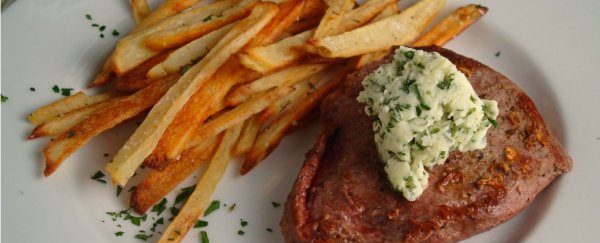It turns out that instead of just steak – rare as possible, please – the real Palaeo diet may have been more of a steak-and-potatoes affair.
In a paper in the September issue of The Quarterly Review of Biology, the authors argue that carbohydrates, especially from tubers (starchy plants like potatoes), were a key source of nutrients that may have helped us develop our particularly large brains.
That's right: carbs, in a Palaeo diet. The key to this argument is some genetic detective work that goes back to when our ancestors' brains started to dramatically increase in size, about 800,000 years ago.
As Carl Zimmer explains in The New York Times, we know that adding meat to hominin diets (which probably happened about 3.3 million years ago) changed our nutrient intake significantly.
At some point, our ancestors began to cook that meat, providing even more protein and fat. This is why Palaeo dieters argue that foods like protein, meat, fruits, and vegetables are the key to eating healthy; and that we didn't need or consume carbs like grain or potatoes in our pre-agriculture days.
But the researchers behind this new paper disagree. Our brains are energy-hungry, and we needed as much energy as we could get. When we started cooking meat, we also would have been able to start cooking starchy tubers. Cooking starchy foods makes them much easier to convert into glucose, our energy source – provided we could digest those tubers in the first place in those days before we started farming wheat.
Humans have an enzyme, amylase, that helps us pull nutrients from starches. We have a lot more copies of the amylase genes (up to 18) than our closest relatives, chimpanzees, who only have two.
Zimmer explains that until recently, we thought we'd evolved to have these amylase genes with the invention of agriculture, a few thousand years ago. But he says that recent DNA analyses of pre-agricultural hunter-gatherers show that they too had the amylase genes that allow us to get extra energy from tubers. So we could have been digesting starch, a great source of glucose, long before we started farming. And if we could, and it was a great energy source, why wouldn't we?
For that reason, the authors of the new paper argue that we evolved those amylase genes around the same time as we started cooking – giving us access to the foods that could have fuelled our hungry brains.
There's obviously still lots we don't know about the exact diets of our Palaeolithic ancestors, and this doesn't prove that we necessarily evolved those genes that help us take advantage of starches at the same time we started cooking. We just know now that we had them before we started farming.
If you're trying to eat healthy by eating as our ancestors used to, know that they most certainly could digest and appreciate calories from carbs – and it's quite likely that they did. But bear in mind that even the premise of the Palaeo diet is a bit off.
While cutting out processed foods is certainly healthy, hunter-gatherers are not uniformly in good health, and their diet is not necessarily one we should be trying to mimic anyway. As Ferris Jabr wrote in Scientific American: "Hunter-gatherers in the Palaeolithic hunted and gathered because they had to. Palaeo dieters attempt to eat like hunter-gatherers because they want to."
This article was originally published by Business Insider.
More from Business Insider:
